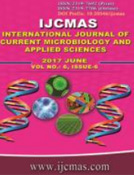


 National Academy of Agricultural Sciences (NAAS)
National Academy of Agricultural Sciences (NAAS)

|
PRINT ISSN : 2319-7692
Online ISSN : 2319-7706 Issues : 12 per year Publisher : Excellent Publishers Email : editorijcmas@gmail.com / submit@ijcmas.com Editor-in-chief: Dr.M.Prakash Index Copernicus ICV 2018: 95.39 NAAS RATING 2020: 5.38 |
An investigation was undertaken during summer 2015, kharif 2015 and rabi 2015-2016 at the Central Research Institute and department of Seed Science and Technology, OUAT, Bhubaneswar to find out the influence of growing seasons on various chemo-morphic traits determining plant growth and seed yield in five varieties/genotypes of sesame viz., Uma, Amrit, Nirmala, Prachi, Cums 17. Observations were recorded on six plant growth characteristics viz., days to initiation and completion of 50% flowering, days to initiation of capsules, plant height and number of primary and secondary branches, six yield attributes namely number of capsules/plant, seeds per capsule, length, width and thickness of capsules, 1000 seed weight and per plant seed yield. The pooled values of different traits over 3 growing seasons indicated that Prachi was the earliest to initiate flowering (33.57 days) and complete 50% flowering (40.57 days), 1000 seed weight(3.12g) and per plant seed yield (8.207g). However, the higher seed yield (8.045g) in Nirmala was due to increased number of capsules per plant (61.01) and number of seeds per capsule (48.69). The pattern of variation of different traits among the varieties was found to be similar in all the three growing seasons. The results indicated that the kharif season is ideal time for Sesamum seed production followed by summer season.
 |
 |
 |
 |
 |